How to Use a Fermenting Crock
Oh Lardy! is a participant in the Amazon Services LLC Associates Program, an affiliate advertising program designed to provide a means for us to earn fees by linking to Amazon.com and affiliated sites.
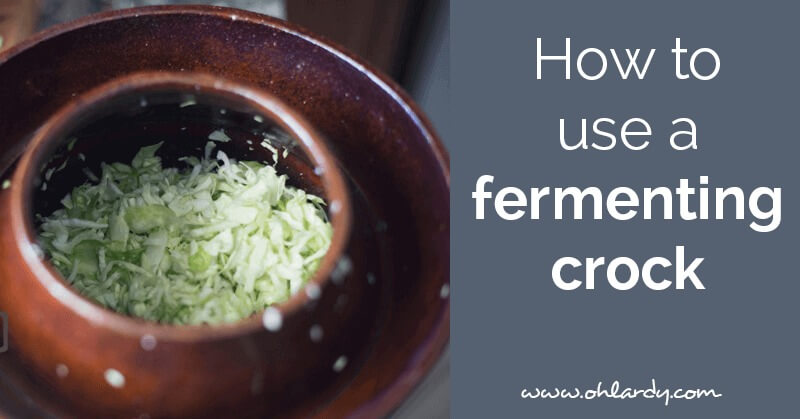
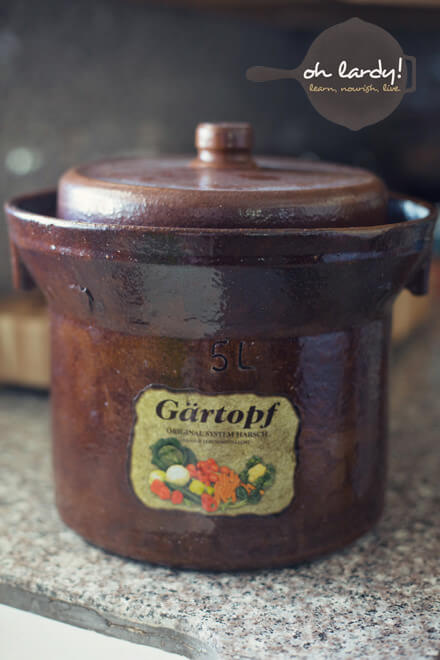
I received this Fermenting Crock from my husband for Christmas and I am so excited!! Up until this weekend, I have only ever used mason jars for my ferments. On Saturday morning, the kids and I headed to the Farmer's Market and I brought home 5 pounds of cabbage (among other things) to make a sauerkraut! But, before I get to that, let me walk you through what makes this crock so cool.
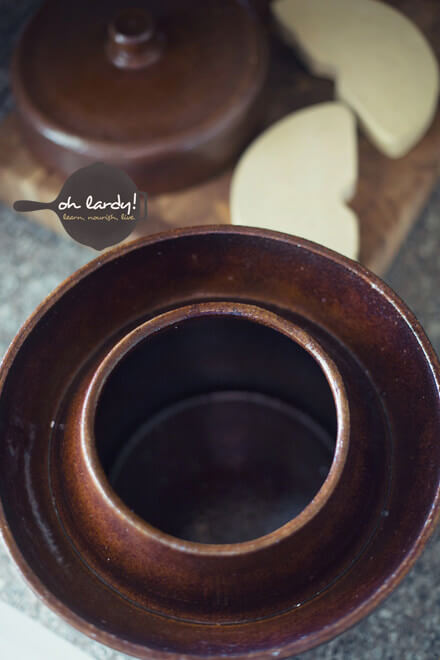
This particular crock is 5 liters. A whole gallon, friends. That is a lot of fermented food! For the record, you can get a 50 liter crock. FIVE ZERO! Where would someone put that thing? Anyway, this crock is a nice, big vessel with two stone weights and a heavy lid.
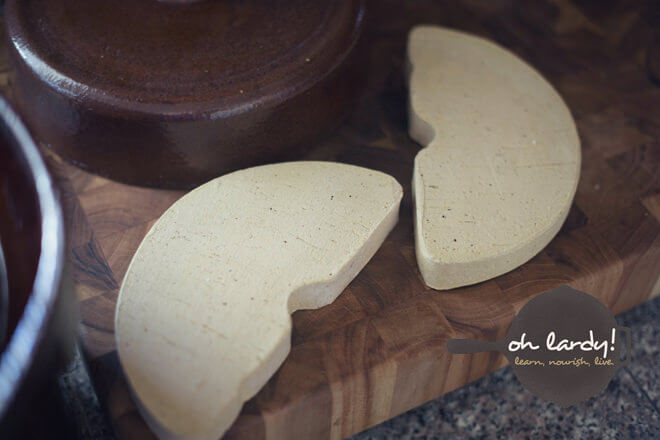
The weights are placed on top of whatever it is you are fermenting to keep it below the brine. After I washed all of the parts and pieces (which are heavy, by the way), I got started on making my sauerkraut.

I used my food processor to shred my cabbage this time because I had a lot of cabbage to get through. As I completed shredding one head of cabbage, I put it in the crock and sprinkled in a Tablespoon of salt and mixed it up with my hands to let it start macerating. In hindsight, I should have mixed all of the cabbage and salt in a big pot and then added it to the crock. That would have made packing it down a lot easier!
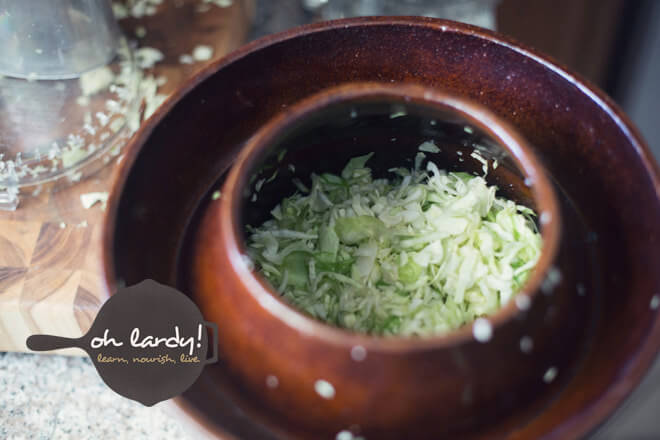
As you can see, two heads of cabbage comes nearly to the top of the crock. I still had another head of cabbage to add! Don't worry, it all fit. As I added a head of cabbage, I added another Tablespoon of salt and mixed.

Once all of the cabbage and salt was in the crock, I used my hand to pack it down and release the brine. If you don't see a lot of brine, wait 10 minutes and pack it down again. The brine will come.

Once I had a decent amount of brine, I added the stones to the crock. I was a bit nervous (this being my first time and all) that there wasn't enough liquid, so I added a bit of filtered water to ensure the stones were covered adequately.
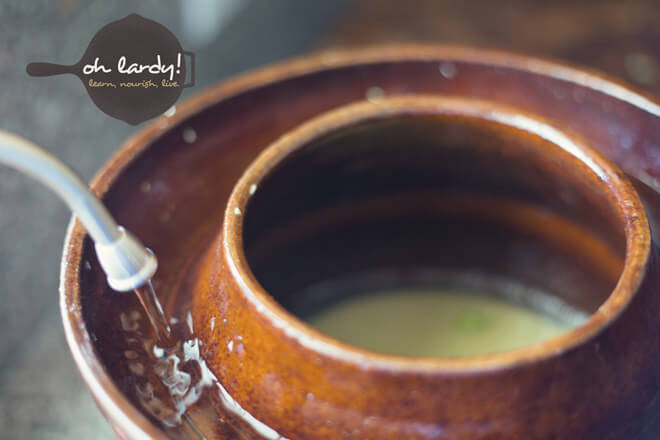
This is probably my favorite part of the crock. There is a trough where I am to add water to create an air lock!! Yippie! (I am such a fermenting nerd.)
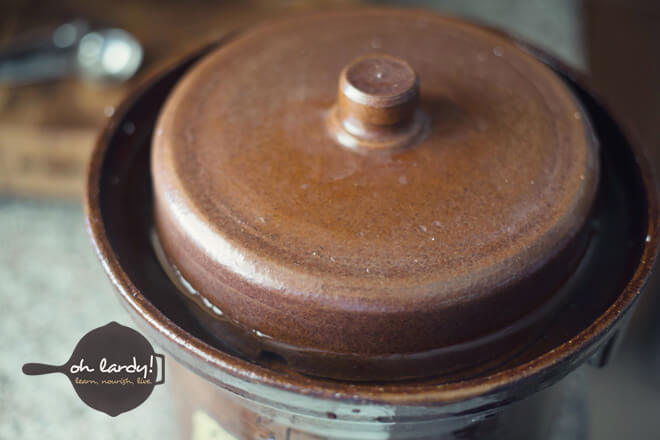
And there we have it, friends. The lid is put on and the air lock is created. If you look closely, you can see a little notch in the lid. This is where bubbles escape. When the ‘kraut really gets kicking, I may take a video for you! For now, I pushed it back into a corner of my kitchen and I wait. For TWO WEEKS! I am not even supposed to crack the lid to peek. So, I will be patient and wait.
Stay tuned for the end result. I am sure it will be fantastic! I just love my new crock!
Does the topic of fermenting baffle you? We created a Fermenting eCourse just for you and when you sign up, we will send you a Quick Start Guide! Grab the eCourse and the guide here!
Sauerkraut
Ingredients
- 5 pounds of cabbage
- 3 tablespoons sea salt
Instructions
- Shred cabbage and layer it, with salt, into your crock.
- Pack it down to release the brine.
- Add weighted stones and add filtered water if needed.
- Add water to the trough and place the lid on top to create an air lock.
- Wait at least 2 weeks before tasting. However, you can let it continue to ferment for up to 6 weeks.
Enjoy!
How do you like to make your sauerkraut?

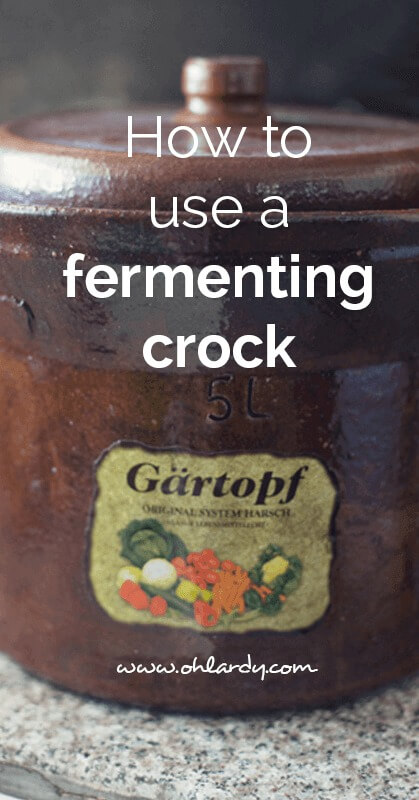
Waiting for my crock to arrive. Thanks for the great pictures and instructions. I am a little confused about the last two steps. Did you pour more water on it once you placed the lid. Doesn’t it go into the crock by that hole?
The water put in the trough is there to create an air lock once the lid is placed. There is a little notch in the lid where, as the ferment starts to kick off gas, bubbles are able to escape. The water that is in the trough does not go into the crock itself. Does that make sense? Let me know if I can answer any more questions! Let us know how your crock adventures go!!
Oh I’m sure when I have it in hand I’ll be comparing each photo and figure it out. You actually made it simple and unintimidating so I decided to buy the crock and go for it. Thanks.
The crock also comes with great directions! You will be fine. I get to taste my sauerkraut this weekend and I am so excited. I haven’t even peeked!
Can’t wait to hear how it turns out! You are a model of self restraint!!!
Our family is just finishing it’s first kraut. To the recipe, I also added a little onion, carrot, oregano and basil. It is wonderful. We will ferment Kimchi next!
That sounds amazing!
I don’t use salt in my kraut. Shread cabbage leaving large outer leaves. put it in a large bowl or crock. cover with the outer leaves. Put a plate on it with a hugh stone on it. Each day take off the stone and plate and roll the liquids around then replace plate and stone. When it is fermented you will know. K:-)
I would imagine that the naturally occurring bacteria on the cabbage would be enough to ferment it. I haven’t tried this, though. We really enjoy the salty flavor too much to skip the salt. How is the flavor?
i made a batch of sauerkraut using this type of crock . Wasn’t sure if I did it right. but this looks like how mine turned out. Do use this crock for other ferments?? and what are those recipes. i am going to make another batch of sauerkraut because my last batch is almost gone. Only 2 weeks to be done?? someone told me 5 – 6 weeks
Michelle, what I have read is that it can take anywhere from 2 to 6 weeks, depending on the temperature of your kitchen. My first batch was 3 weeks. I tasted it at 2 weeks and it was good, but I wanted to see what could happen. 4 weeks was good, too, but I could see that the longer it went the more sour it would get. My kids like kraut, but it can’t be too sour. So, I am happy with the 2 week ferment for flavor for now. As far as other ferments go, I have some pickles that I am ready to put in the fridge. The recipe is forthcoming!! YAY!
I wanted to make sauerkraut last year (and even grew the cabbage for it), but the process looked too confusing. Thank you for this post! Where do you get your crock? Also, if I want longer term storage, would I can the kraut?
Thank you!!
I believe my husband found my fermenting crock on Amazon. However, I am not sure they sell that brand anymore. Any crock will do, of course! You wouldn’t can the sauerkraut. That would kill all of the beneficial bacteria. I put my kraut in my fridge and it keeps for a LONG time. 🙂
I love the traditional fermentation crock! One problem that I had with mine though is it seemed like I kept getting mold every few batches. I still like my original crock but I use a little more modernized fermentation jar because I can use the same recipes but I have never had a problem with mold or strange odors since I switched! This is the jar that I just bought:
Hi, thank you for posting this recipe for a 5 liter crock. Can you tell me how much sauerkraut you get from this recipe?
Usually about 4-5 liters or quarts. It depends how full you pack the crock!
Thank you so much for this! I just received my crocks from Germany yesterday—two 5 liters, just like yours. Honestly, they are bigger than I had envisioned in my mind, but now I will have a veggie ferment going as well as a fruit. And I can’t wait to start the drinks, too!
They didn’t come with instructions, just recipes—so thank you–precisely what I needed!
I’m the founder/moderator for Punk Domestics (www.punkdomestics.com), a community site for those of use obsessed with, er, interested in DIY food. It’s sort of like Tastespotting, but specific to the niche. I’d love for you to submit this to the site. Good stuff!
Sounds great! Thanks!
So glad I found these instructions! I’m getting the 5 liter crock and the reviews had me confused and many said the instructions were in German. Your photos and explanations have helped it all make sense.
My folks always made sauerkraut in the autumn in a 50 liter crock. Lasted us all winter.
I’ve been making mine in 1 liter canning jars, my favourite being red cabbage and garlic but like trying other flavours as well.
Many thanks!
I’ve been making kraut in 2 Qt mason jars for a while now with great success, using Pink Himalayan salt. My family turns their nose up at store bought kraut since eating homemade, lol. I recently acquired a 10L crock like yours and can’t wait to see how it does in that. I was thinking this size would be great for pickling cucumbers too this year and I read mention of you having a recipe for that as well … I’ll have to search your site. Thanks!
I just ordered a crock. So excited to start this fermenting process!
I have been hesitant to purchase a fermenting crock for a few reasons, they can be expensive, and I like fermenting in the container I’m going to store my veggies in, (less stuff, less dishes). These directions seem pretty simple, are there any particular reasons why you would recommend using a croc over say mason jars and airlocks?
I noticed on some of the recipes it calls for a starter. where would I get a starter and would my homemade keifer work?
Thank you Bev
Hi,
I would like to know where did you purchase the original Gartopf Fermenting Crock. I think it is very hard to get now in the USA. Just purchased one fermenting crock at wisementrading.com, that was advertised as Gartopf Fermenting Crock made in Germany, but what I received was a similar item (like a copy), but without any label and very poor glaze workmanship. I paid $129 for it plus shipping, so these fake Gartopf Fermenting Crock are not cheap. I still want to get the real one, and I hope you can help me.
Thank you
Enrique Iglesias
I got mine a few years ago when they were sold on Amazon.com. I have noticed that they haven’t been available for a while now. Sorry I can’t help!
What is a good location for the crock during the process? And a good temperature of the room? I was thinking of putting it on the floor of our kitchen in one of the corners but it can get a little warm sometimes there. Any help would be appreciated.
This looks like such a great tool to make it much easier to ferment what I want! I want to try more sauerkraut, but also onions, beans, and pickles. I hope those will all work perfectly with this crock when I try it out. Thank you for sharing! Do you have a favorite thing to ferment in your crock?
Hi, I have made a first batch with a similar gartopf 20 L crock (!). Left it for about 2 weeks. And… there was mold when I opened it. Wondering if it may be because some of the water from the moat had evaporated…? I didn’t fill the crock to the top (couldn’t have lifted the thing), just about 1/3rd.
I removed the mold and the kraut was fine but I’d like to improve and not have to go through the gross and lengthy process of trying to remove mold from inside a 20L dark crock — not an easy process…!
Any tips?
Thanks!
Jess, I’m just getting into this myself, but my family made kraut for years. As I recall its very important that the cabbage is completely submerged in the brine liquid to prevent/reduce mold on top. Keeping that water channel filled helps as well I am told
This page was exactly what I needed. like lots of people, I grew up with relatives who made kraut but never did it myself. I was a little nervous going into it. I picked up a raw rutes yaozu fermenting crock for starting purposes. Now this is a small, white little fermenting crock about 2 liters. I followed your guidelines as the crock itself seems to work on a similar principal. I’m about three weeks into fermetning my first batch and the taste is fantastic! Thank you for taking the mystery out of the process!
I want one now!
I’m loving making my own kraut! I’ve read a lot about the process, and the consensus seemed to be that the cabbage needed 3 weeks to get just right. Now that I’ve jarred it up and put it in the fridge, I find that it gets better as it sits! My next batch I will ferment for 4 weeks. I just ordered a 5L crock as the 2L I purchased just didn’t make enough as I wanted to share some with my family.
So I just got my Nik Schmitt Fermenting crock. I put 3 huge heads of Cabbage in the crock with the appropriate amount of salt and put it in the corner of my Kitchen. My only problem is my Beagle keeps drinking the water out of the trough. She has her own water bowl but prefers the water in the crock. She is a little spoiled and thinks everything is hers!
Will this ruin or slow the fermenting process? I do fill it every time I see it empty.
Also, I see that you said NOT to can the saurkraut. Can I freeze it?
I have never frozen fermented foods. It will last a very long time in your fridge if you don’t eat it all first!
I never can my kraut anymore. I always double freezer bag my kraut, put it in the freezer and it lasts for at least 2 years.
I have made sauerkraut several times in the Gartopf crock. I have the 50 liter and it is and heavy.
This year I had 35# of cabbage cut in my food processor. It filled the crock just over half. I set it up in the basement where it is a consistent 60 degrees. It will remain there for 6 weeks. Since it is too heavy to move it around I prep everything in my kitchen then transfer it to the crock in the basement. Works out great. I got my crock about 15 years ago from Germany. Love it. I also have a 5 liter like the Gartopf but it has no brand name on it. Looks pretty much like the same thing though. Heavy too.
I’ve always used the same recipe that you mentioned. I do can mine in pint jars though.
Hello! I have a 25 liter Gartopf. I noticed during the fermenting process that the water I filled at the top kept disappearing. I waited 6 weeks and then opened it up today. Looks like all that water was sucked inside. I took out the weights and leaves from the cabbage. I scooped out all the water. I tasted the kraut but it was very watered down tasting. It smells like kraut but not what I was expecting. Is there a fix for what I have now or do you think this batch has gone bad?